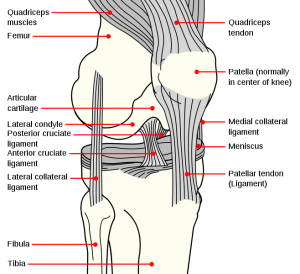The Anterior Cruciate Ligament, or ACL, is one of the most important structures in the knee. Most people know that they do not want to injure this ligament, and that if they do, the recovery time can be many months. But what else do we know about this crucial ligament?
- this ligament, located in the center of the knee is 3.5 cm (about 1.5 inches) in length
- crosses its sister ligament (posterior cruciate) to form an “X” (thus the name cruciate–Latin for cross)
- attaches in front of the posterior cruciate (anterior means towards the front) on the leg bone (tibia)
- main function is to resist the forward movement of the tibia
- secondary function is to resist rotation of the lower leg
- the ACL is weaker than the PCL
- most animals that have knee joints have an ACL-like structure
- the ACL is the most commonly injured knee ligament
- in the USA, approximately 100,000 ACL tears occur every year
- in the USA, 65-70,000 ACL surgeries are performed every year
- most ACL tears occur in non-contact situations

For more information, visit our ACL Physical Therapy page.
